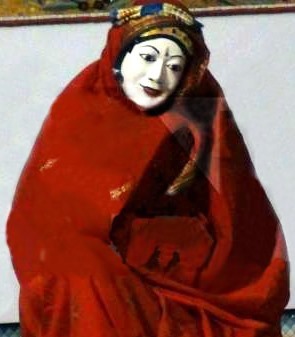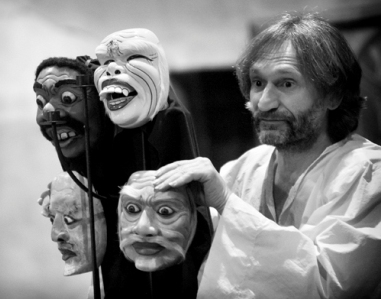|
Music by Franz Liszt
|
Liszt composed this "Via Crucis" for a four hands piano with short vocals, calling for the inclusion of the harmonium.
The titles of the fourteenth stations reflect the popular tradition of Via Crucis, with the three falls of Christ and the scene of Veronica, not mentioned in the canonical Gospels. The form chosen for this theatrical representation arises from the counterpoint between the music of Liszt and quotations from the Gospels, according to the traditional Christian liturgy. In particular, we have considered the texts of the Via Crucis held in Romein 1994, presided over by Pope John Paul II, and agreed along with the Ecumenical Patriarchate of Constantinople. Some masks of the sacred tradition of Topeng in the island of Bali (Indonesia) give the face to the displayeded characters: Anna, Caiaphas, Pilate, Herod, Mary, Simon of Cyrene, Veronica, Centurion, the two thieves. The narrator and the Christ only appearing with the performer's face.
Davide e Daniele Trivella, twins, formed a piano duo considered among the most significant in the international music scene. Their performances have unanimously impressed the jury of the most important national and international competitions, always receiving first prizes, last one the prestigious Murray Dranoff Miami. The great success decreed by the victories in these contests, led them to hold recitals for major concert associations in Italy, England , Austria, France , Germany, Israel, Russia, Thailand, America and South Africa, in which the audience present, formed also by critics and personalities known in the music world, was caught by their style, the extraordinary understanding and great communication skills and interpretation. In 2000, as part of the Venice Biennale, they performed in concert, with the pianist Pierre- Laurent Aimard, transcripts and piano works of Schoenberg receiving considerable acclaim from audiences and critics. Their versatility is expressed in a repertoire that ranges from the eighteenth century to the present day, including fundamental pieces of the twentieth century such as "Visions de l'Amen" by Messiaen, Hindemith sonatas, op .16 orchestral pieces by Schönberg / Webern, Stravinsky's works for the duo, Monument Ligeti, as well as compositions that revolve around the sphere as jazzy like Gershwin, Piazzolla, Giovanni Sollima and Gianluigi Trovesi, often reworked from them, and moreover works by contemporary composers such as Ernesto Rubin de Cervin (Offers and The Last Choir in first performance). The musical talent of the brothers Trivella was formed in Milan with Alberto Colombo, by the Music Academy of Florence with Pier Narciso Masi and thanks to meaningful encounters with Katia Labàque by Chigiana Academy of Siena, and moreove by Alfons Kontarsky at the Mozarteum in Salzburg, Alexander Lonquich Loano, Bruno Canino in Milan and Dussaut Therese in Paris. Since the meeting with the Enrico Masseroli they began their experience with Balinese music too. Their concerts have been broadcast on Rai Tre, Radio France, Radio Israel, Bayern 4. Recorded for Phoenix. to be remembered the tourneè, as solo, duo and trio at the Festival of chamber music "Cape Classic" (South Africa) in February 2006. In addition, thei had been engaged to play in America to play the concert for two pianos and orchestra of Morton Gould, in Bangkok, for the bicentenary of Mozart, the concerto for two pianos of genius from Salzburg by Warwick festivalin England. Their performance in the festivities organized in February 2010 to celebrate the tenth anniversary of their victory in the competition Murray Dranoff Miami, sparked a real enthusiasm as well as the participation in the International Piano Festival of Brescia and Bergamo with the concert - lecture series "Variations on the water", cared by Mimma Forlani, of which was produced a forthcoming book and CD with works by Liszt, Debussy, Ravel and Rachmaninoff. Technical requirements:: The "sacred representation" can take place either in the churches or other places of worship, either in halls or auditoriums. In churches the table/altar and the balustrade become the place where to set scenic masks and drapes, used to dress the characters. In other areas will require two tables, or a table and a bench. A well-tuned piano and either a harmonium or an organ are needed. |
I - 24129 Bergamo tel / fax: 035 23 30 94 tel mob.: 333 45 30 146 email: pirshiptheatre@virgilio.it |

